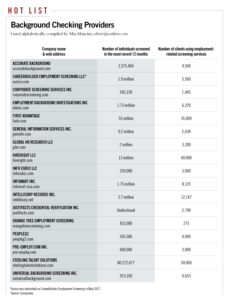Evolutions in background screening technology is making the process faster, easier and a little less annoying.
Background screening is arguably the worst part of the recruiting process — both for recruiters and prospective employees. It’s time consuming, requires a lot of data entry and adds delays and anxiety to the hiring process. Companies that are trying to win over promising candidates are looking to their background screening vendors to make this process less painful.
“In the war for talent, candidate experience has become very important,” said Clare Hart, CEO of Sterling Talent Solutions in New York. “They want to get employees into the organization sooner, and to be sure they have a positive experience getting there.”
85% of respondents to a survey say that they have found a lie or misrepresentation on a resume and/or job application.
Mary O’Loughlin, managing director of health care at HireRight in Irvine, California, agreed. HireRight’s 2017 background screening report shows reducing time to hire has become the most significant background challenge companies face. “Speed has become a critical component of the screening process.”
This has spurred background screening vendors to update their solutions, adding customization features and standardized forms to make the screening process a more positive experience. These include real-time updates so candidates see where they are in the process, e-signature options, branded interfaces and better integration with application tracking systems. “ATS integration has been a trend for a long time,” Hart said. “Where it used to be innovative, now it’s ‘the price of entry.’ ”
The screening process also has to be accessible via mobile devices, O’Loughlin said. Roughly a third of candidates now complete their entire process via mobile, and that percentage will likely rise as more millennials and Generation Z employees enter the workforce. “A lot of times they don’t even want to get updates via email,” she said. “They want everything via text.”
Gig Workers Need Screening, Too
Beyond customer experience, companies are increasingly interested in screening tools for contract workers, who made up 40 percent of the U.S. workforce in 2015, according to the U.S. Government Accountability Office.
“More organizations are employing contingent, contract or temporary workers to meet hiring demands — and screening this population is becoming commonplace,” O’Loughlin said. Fully 86 percent of companies now screen contingent workers — up from 41 percent just five years ago. It’s a reflection of the growing reliance on temporary project workers, who often have the same level of access to company knowledge and databases as full-time employees.
“If you treat contingent labor as an extension of the workforce you need to recognize the risks,” she said.
Many of these screening challenges will be addressed by evolving industry standards that will create greater uniformity in the background screening process, said Kim Bartkus, executive director, HR Open Standards Consortium Inc., a nonprofit organization that develops HR related standards.
While there are already some standards in place, the background screening work group is developing new standards for gathering, sending and sharing candidate information to make it more seamless and consistent.
“If everyone is using the same formats, it will speed the process and reduce errors and missed information,” she said. “That benefits everyone.”
How to Choose
Companies currently vetting their background screening vendors should start by reviewing the tools with their own pain points in mind, O’Loughlin said.
“Think about the people you want to screen, and whether the features they are offering will improve your hiring process.”
They should also look for vendors that can deliver proof of value through performance data, Hart said. She sees many companies today asking vendors to provide stats on key metrics like turnaround time, hit rates (when candidates have negative screening results) and customer service requests.
For example, getting a high hit rate may indicate that they need to review where they are sourcing candidates; and if there is a spike in customer services calls it can indicate a problem with some aspect of the screening process.
“There is a lot of valuable information out there to help companies understand how their program is working,” she said. The more they push for these numbers, the better the overall screening process — and the candidate experience — will be.
Sarah Fister Gale is a writer living in Chicago.



